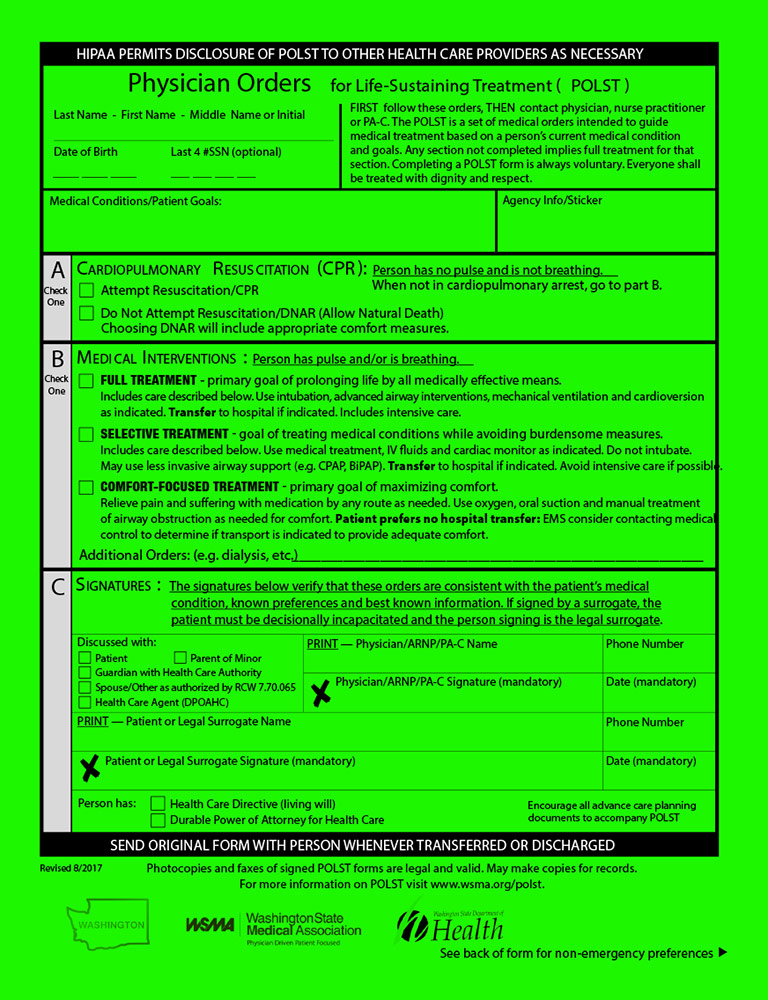If you have a loved one with a terminal illness, or if they are at the end of their life and live in an independent apartment or domain, they will likely be eligible to have a POLST form. As part of an Advanced Directive or Advanced Care Planning (ACP) an individual has a right in Washington State to direct medical professionals and paramedics on actions that should be taken if they are discovered in a vegetative or unconscious state.
The ACP is your very personal desire for end of life remedies that would require artificial means to revive them or keep you alive and will speak for you if you are not able to speak for yourself. Having a plan like this is always a must for someone with a serious, life-ending diagnosis, or also later life seniors who live in their home.
Specifically, as part of the ACP, a POLST form stands for Physicians Order of Life Sustaining Treatment. It represents and honors a patient’s wish to end-of-life planning based on conversations between patients, loved ones, and health care professionals.
The POLST form is a bright lime green document that represents your wishes and is recommended to be placed in the home on the refrigerator so that if EMTs are called to the home the paramedics will understand what specifically a patient’s wishes are. Per this form, the EMTs will act accordingly.
The POLST form is designed to ensure that seriously ill or frail patients can choose the treatments they want or do not want and that their wishes are documented and honored.
The POLST form assures patients that health care professionals will provide only the treatments that patients themselves wish to receive and decreases the frequency of medical errors.
POLST is not for everyone. It is recommended only for patients with serious illness or frailty, for whom a health care professional would not be surprised if they died within one year. For these patients, their current health status indicates the need for standing medical orders. For healthy patients, an Advance Directive is an appropriate tool for making future end-of-life care wishes known to loved ones.
 Even for those who have an advance directive, a POLST form is recommended for the seriously ill or frail.
Even for those who have an advance directive, a POLST form is recommended for the seriously ill or frail.
The POLST form includes information about:
- Preferences for resuscitation
- Medical conditions
- Preferences on the use of antibiotics
- Preferences for artificially administered fluids and nutrition
The POLST form must be completed by your doctor or other healthcare provider only after a discussion of end-of-life choices with a patient or his or her legal decision-maker. The form is then signed by the doctor, nurse practitioner or physician assistant and the patient or his or her legal decision maker. It then becomes a medical order that is understood and followed by other healthcare professionals.
In what setting is the POLST form used?
The POLST remains with and travels with the patient between care settings, home, hospital, long-term care or any other facility.
Where is the POLST form kept?
In the home, the form is kept in a prominent place, such as the refrigerator, a bedside table or medicine cabinet. For patients who are in a healthcare facility, the form is kept in the medical chart.
What are some of the terms used when POLST is discussed?
- Artificial Nutrition When a patient can no longer eat or drink by mouth, liquid food can be given to them by tube.
- Cardiopulmonary Resuscitation (CPR) Attempts to restart breathing and the heartbeat of a person who is not breathing and who has no heartbeat. Typically this involves “mouth-to-mouth” and forceful pressure on the chest. It can also involve electric shock or a plastic tube being placed in the windpipe to assist breathing.
- Comfort Measures Care undertaken with the primary goal of keeping a person comfortable, rather than prolonging life. With a POLST, a person who requests “comfort measures only” would be transferred to a hospital only if needed for his or her comfort.
- Intravenous (IV) Fluids administered through a small plastic tube directly into a vein, typically on a short-term basis.
- Mechanical Ventilation/Respiration The pumping of air in and out of the lungs through a tube in the throat. Used when a person is not able to breathe on his or her own.
- Tube Feeding Short-term basis: Fluids and liquid nutrients can be given through a tube in the nose that goes into the stomach. Long-term basis: a tube inserted through a surgical procedure directly into the stomach.
Even if someone already has an advanced directive, completing the POLST form with the patient defines clearly their options for treatment with a medical professional who may be able to clarify better, based on their condition, what the possible outcomes may be if a certain life sustaining measure is something they wish for or something they have denied.
A POLST form should be completed while the patient has the capacity to make decisions.
As the new year begins, of course, it is always wise to have conversations about later life care, or advanced care directives. Discuss with your doctor if the POLST form may be an important document that should be included.












